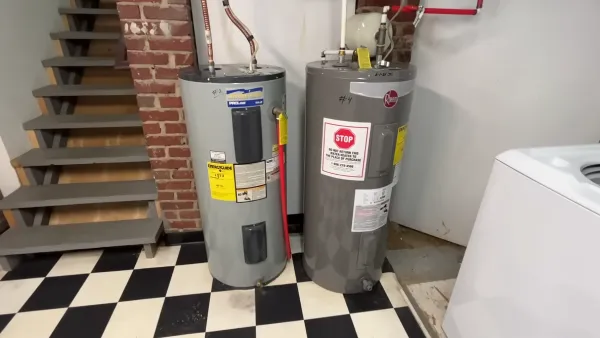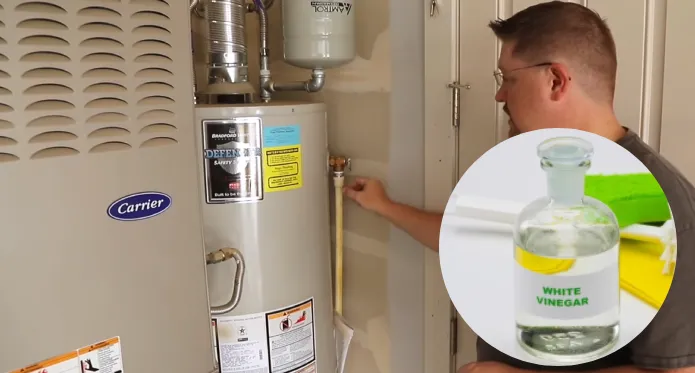Last Updated on September 7, 2023
Mineral deposits and sediment buildup in the heater can negatively impact energy efficiency and cause mechanical problems. Thus, cleaning your water heater periodically becomes crucial to avoid such issues. While there are several ways to clean a water heater, vinegar is one of the easiest and most effective methods.
To clean your water heater using vinegar, turn off the power supply and gas valve to the water heater. Then, drain the tank by opening the drain valve and flushing out any sediment or debris.
Finally, mix equal parts vinegar and water and pour it into the tank, allowing it to sit for a few hours before draining again.
We will demonstrate below how to clean your hot water heater (tank and tankless) using vinegar. Following these simple instructions, improve your appliance’s performance and save money on energy bills.
How to Clean Hot Water Heater With Vinegar: 2 Methods

Over time, minerals like lime and calcium can accumulate, causing your water heater to work harder and less efficiently. But you can tackle this issue head-on with a simple DIY solution: vinegar.
Here are the simple DIY steps to follow:
Cleaning a tank water heater using vinegar
- Step 1: Power down and shut off
- Step 2: Empty the tank
- Step 3: Uncover the anode rod
- Step 4: Introduce vinegar into the tank
- Step 5: Reinstall the anode rod
- Step 6: Circulate the solution
- Step 7: Let it sit
- Step 8: Drain, refill, and restart the heater
Cleaning a tankless water heater using vinegar
- Step 1: Prepare the heater
- Step 2: Install the Submersible pump
- Step 3: Connect the Other Hose
- Step 4: Initiate the cleaning process
- Step 5: Turn off the pump and flush
- Step 6: Clean the thermocouple and filter (if the unit has one)
- Step 7: Resume operation
Let’s discuss these 2 two approaches with steps in detail:
Cleaning a Tank Water Heater Using Vinegar
Cleaning the tank with vinegar can help remove the buildup and restore it to its original state.
Materials You’ll Need:
- Socket Wrench (1 & 1/16th”)
- Funnel
- 1-3 Gallons of Vinegar
- Teflon Tape
- Hose
- Towel
- Bucket
Step 1: Power Down and Shut Off the Heater
First, ensure you’ve turned off the power to your water heater at the circuit breaker and shut off the main water supply.
Step 2: Empty the Tank
Now, open a nearby faucet to relieve pressure and attach a garden hose to the drain valve at the tank’s base. Ensure the other end of the hose is positioned in a suitable drainage location.
Once everything is set up, open the valve on the tank and allow it to drain fully. This will remove any sediment or debris that may have accumulated inside, ensuring optimal performance and efficiency of your water heater.
Step 3: Uncover the Anode Rod
Once you’ve drained the tank, it’s time to uncover the hexagon-shaped anode rod on top of the hot water heater. Grab a 1 and 1/16-inch socket wrench and carefully loosen and remove the anode rod.
If you notice any signs of wear or corrosion, it may be necessary to replace the rod to ensure optimal water heater performance.
Step 4: Introduce Vinegar into the Tank
If the rod is exposed, add vinegar to the tank. Place a funnel securely into the opening for the anode rod, ensuring a tight fit.
Carefully pour 2 to 3 gallons of vinegar into the tank through the funnel. As a natural cleaning agent, vinegar will effectively break down and dissolve mineral deposits in your water heater.
Step 5: Reinstall the Anode Rod
To complete the process, securely place and tighten the rod back into its position using the socket wrench. Insert the rod into the designated hole and rotate it clockwise until tightly secured. Take your time to ensure a secure fit for optimal performance.
Step 6: Circulate the Cleaning Solution
Now turn on the cold water supply and let the vinegar solution circulate inside the tank for about 5-10 minutes. The vinegar solution will break down any mineral deposits or sediment that may have accumulated over time.
As it circulates, it will dislodge these impurities, allowing them to be flushed out through the drain valve later. This process ensures optimal performance and longevity of your water heater.
Step 7: Let It Sit for a Few Hours
Allow it to sit inside the tank for at least 6 hours, effectively allowing the solution to dissolve stubborn mineral deposits. During this waiting period, the vinegar works magic by breaking down and loosening any built-up scale or sediment within the hot water heater.
Step 8: Drain, Refill, and Restart the Heater
After letting the vinegar sit for a few hours, open a hot water faucet and the drain valve at the heater tank’s base. Connect a hose to direct the water to a drainage point. Once drained, close the valve and faucet, then turn on the cold water supply to refill the tank. If vinegar is still mixed in the water, you may need to drain it again.
Cleaning a Tankless Water Heater Using Vinegar

Cleaning a tankless water heater is a bit more complicated than cleaning a tank water heater, but the process is still relatively simple.
Materials You’ll Need:
- 1/6-horsepower sump pump
- 3 gallons of food-grade white vinegar
- 5-gallon bucket
- Two 2 – 4-foot rubber hoses (red and blue)
Step 1: Prepare the Heater
Turn off the gas or circuit breaker for your water heater. Locate the access panel or cover and remove it, following the instructions in the owner’s manual. This will allow you to access the water heater’s interior for cleaning.
Next, turn off the water supply to the heater and open the pressure valve to release any built-up pressure.
Step 2: Install the Submersible Pump
After turning off the gas or circuit breaker, locate the access panel and remove it to prepare for setting up the pump. Once the panel is removed, locate the cold-water service port on the heater.
Securely fasten one end of the hose to the cold-water service port and connect the other to your sump pump.
Step 3: Connect the Other Hose
The second red hose will be used to connect to the hot-water service port on the water heater. This will allow for proper circulation of vinegar through both cold and hot water lines, effectively cleaning your hot water heater.
Step 4: Initiate the Cleaning Process
To start the cleaning process, turn on the sump pump and ensure that the water heater’s hot- and cold-water service ports are open.
The vinegar will cycle through the system, entering the heater and flowing back into a bucket. Let the vinegar circulate for at least an hour to dissolve and remove mineral buildup effectively.
Step 5: Turn Off the Pump and Flush
Now, turn off the sump pump and flush out any remaining liquid in the system. Locate the sump pump and switch it off to prevent accidents or damage.
Next, take a bucket and carefully dispose of the vinegar solution used for cleaning. Then, remove the pump hoses from the water heater to prepare for flushing out any remaining vinegar.
Step 6: Clean the Thermocouple and Filter (If the Unit Has One)
Now, clean the thermocouple with steel wool or sandpaper. If your water heater unit has a filter, clean it accordingly. To clean the filter, start by soaking it in vinegar or rinsing it under running water.
Step 7: Resume Operation
To resume water heater operation, turn on the water heater and restore gas or power. Ensure that all connections are secure and functioning properly. Check for any leaks or unusual sounds during the startup process.
Once the system runs, set a reminder for annual maintenance based on water hardness and usage to ensure optimal performance. Regular monitoring and maintenance will prolong the life of your water heater.
Is it safe to put vinegar in a hot water heater?

According to professional plumbing advice, using vinegar in your hot water heater is completely safe and can help remove sediment buildup over time. It’s an easy and conversational way to maintain the longevity of your water heater.
However, you should follow manufacturer instructions or consult with a professional if you’re unsure about the uses of vinegar and other cleaning solutions in your water heater.
Boost Your Hot Water Heater’s Performance with Vinegar Cleaning
Cleaning your hot water heater by using vinegar is a simple and effective way to maintain its performance and prolong its lifespan. You can easily remove mineral deposits from your heater by following the steps outlined above.
Did you know that according to a study conducted by the U.S. Department of Energy, regularly cleaning your water heater can increase its efficiency by up to 30%? So don’t forget to incorporate vinegar cleaning into your regular maintenance routine for optimal results.

